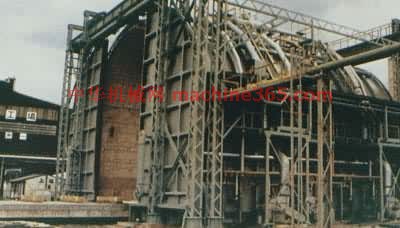1) hydrothermal post-treatment


水热后处理
1.
8O3 nano-powder with an average grain size about 50-100 nm was prepared by a low temperature aqueous solution method combined with hydrothermal post-treatment.
采用低温液相法(LTAS)制备浆料结合水热后处理工艺,得到分散性良好、羟基缺陷少、平均粒径为50~100nm的BaZr0。
2) post welding heat treatment


焊后热处理
1.
This study is concerned with the effect of post welding heat treatment(PWHT)on the microstructure and properties at the intercritical reheated coarse-grained heat-affected zone(IRCGHAZ)of WB36 steel, and investigated whether the PWHT could reduce IRCGHAZ embrittlement.
针对WB36钢(15NiCuMoNb5)临界再热粗晶区(IRCGHAZ)存在的脆化现象,研究了焊后热处理对模拟临界再热粗晶区(IRCGHAZ)组织性能的影响,探讨其改善韧性作用。
2.
This paper studies the technology,equipment and properties of post welding heat treatment of the RE microalloy quenching rail which was heated with medium frequency induction and quenched with pressure air for head of,normalized for other of.
通过热模拟试验选择了合理的焊后热处理工艺参数,恢复了轨头强度和硬度,并大幅度地提高了焊接接头的韧塑性和综合性能,满足了无缝线路铺设使用要求。
3.
It is pointed out that post welding heat treatment will not significantly improve residual stress in dissimilar steel welding joints unless correct and appropriate heat treatment procedures are taken.
文章主要讨论了焊接热处理对火电站管道异种钢焊接接头带来的问题,分析了热处理对接头组织、焊接残余应力的影响,指出通过焊后热处理可以明显改善电厂管道异种钢焊接接头残余应力,但要使用正确和合适的热处理工艺。
3) postweld heat treatment


焊后热处理
1.
Effect of postweld heat treatment on microstructure of electron beam welded joints of Ti_3Al;
焊后热处理对Ti_3Al电子束焊缝组织形态的影响
2.
Numerical value analysis on reduction of welding residual stresses with postweld heat treatment on P91 pipes;
焊后热处理消除P91钢管焊接残余应力的数值分析
3.
Based on Barkhausen Noise,as-welded residual stresses and residual stress after postweld heat treatment of 16MnR(include weld- ing metal,fusion zone,heat affect zone)were measured by using magneto-elastic method with 20~70 kHz frequency & 0.
07mm的STRESS- CAN500C磁弹性应力仪,测量了压力容器用16MnR钢焊后以及焊后热处理的残余应力(包括焊缝、熔合区、热影响区),研究了残余应力的形成、不同区域的分布。
5) Post weld heat treatment


焊后热处理
1.
The application and requirement of post weld heat treatment used by spherical tanks are summarized.
概述了球罐的应用及对焊后热处理的要求,详细介绍了国内球罐热处理技术的新进展,包括电加热法、爆炸法、内燃法、电加热辅助燃油法,还展望了该领域技术的发展前景。
2.
The influence of different post weld heat treatment conditions on the microstructures and mechanical properties of friction welded joints between drill pipe DZ60 steel and its tie in 40Cr steel has been discussed.
同时发现 ,采用合适的焊后回火热处理温度 ,可以有效提高焊接接头的抗拉强度及屈服强度 ,使其各项力学性能达到DZ6 0钻杆管材的技术标准 ,从而有效减少地质钻杆摩擦焊接头焊后热处理工艺 ,降低制造成
3.
The effect of post weld heat treatment on the impact toughness in inertia friction welded joints of carbon steel was studied in this paper The result show that the post weld heat treatment greatly affected the impact toughness of inertia friction welded joints The impact toughness of the welded joints can be improved by an adequate post weld heat treatmen
研究了焊后热处理对碳钢惯性摩擦焊接头冲击韧性的影响。
6) post-weld heat treatment


焊后热处理
1.
Effect of post-weld heat treatment on microstructure and mechanical property of manual SHS welding
焊后热处理对手工自蔓延焊接接头组织性能的影响
2.
The experiment results show that the welding defects can be decreased by using preheat and post-weld heat treatment.
试验表明 ,采取焊前预热 ,焊后热处理的TIG焊工艺进行焊接可以减少焊接缺陷的产生。
3.
Effects of post-weld heat treatment on the mechanical properties of Al-Li alloy 2091 joints are studied in this paper.
研究了2091铝锂合金焊后热处理对焊接接头机械性能的影响。
补充资料:金属热处理 :感应加热热处理
用感应电流使工件局部加热的表面热处理工艺。这种热处理工艺常用於表面淬火﹐也可用於局部退火或回火﹐有时也用於整体淬火和回火。20世纪30年代初﹐美国﹑苏联先后开始应用感应加热方法对零件进行表面淬火。随著工业的发展﹐感应加热热处理技术不断改进﹐应用范围也不断扩大。
基本原理 将工件放入感应器(线圈)内(图1 感应加热原理 )﹐当感应器中通入一定频率的交变电流时﹐周围即產生交变磁场。交变磁场的电磁感应作用使工件内產生封闭的感应电流──涡流。感应电流在工件截面上的分布很不均匀﹐工件表层电流密度很高﹐向内逐渐减小(图2 沿工件截面的电流密度分布
)﹐当感应器中通入一定频率的交变电流时﹐周围即產生交变磁场。交变磁场的电磁感应作用使工件内產生封闭的感应电流──涡流。感应电流在工件截面上的分布很不均匀﹐工件表层电流密度很高﹐向内逐渐减小(图2 沿工件截面的电流密度分布 )﹐这种现象称为集肤效应。工件表层高密度电流的电能转变为热能﹐使表层的温度昇高﹐即实现表面加热。电流频率越高﹐工件表层与内部的电流密度差则越大﹐加热层越薄。在加热层温度超过钢的临界点温度后迅速冷却﹐即可实现表面淬火。
)﹐这种现象称为集肤效应。工件表层高密度电流的电能转变为热能﹐使表层的温度昇高﹐即实现表面加热。电流频率越高﹐工件表层与内部的电流密度差则越大﹐加热层越薄。在加热层温度超过钢的临界点温度后迅速冷却﹐即可实现表面淬火。
分类 根据交变电流的频率高低﹐可将感应加热热处理分为超高频﹑高频﹑超音频﹑中频﹑工频 5类。①超高频感应加热热处理所用的电流频率高达27兆赫﹐加热层极薄﹐仅约0.15毫米﹐可用於圆盘锯等形状复杂工件的薄层表面淬火。②高频感应加热热处理所用的电流频率通常为200~300千赫﹐加热层深度为0.5~2毫米﹐可用於齿轮﹑汽缸套﹑凸轮﹑轴等零件的表面淬火。③超音频感应加热热处理所用的电流频率一般为20~30千赫﹐用超音频感应电流对小模数齿轮加热﹐加热层大致沿齿廓分布﹐粹火后使用性能较好。④中频感应加热热处理所用的电流频率一般为2.5~10千赫﹐加热层深度为2~8毫米﹐多用於大模数齿轮﹑直径较大的轴类和冷轧辊等工件的表面淬火。⑤工频感应加热热处理所用的电流频率为50~60赫﹐加热层深度为10~15毫米﹐可用於大型工件的表面淬火。(见彩图 差温炉淬火 ﹑ 600毫米直径冷轧辊工频感应加热淬火
﹑ 600毫米直径冷轧辊工频感应加热淬火 ﹑ 大型铸钢件的热处理炉
﹑ 大型铸钢件的热处理炉 ﹑ 真空淬火炉
﹑ 真空淬火炉 )
)
基本原理 将工件放入感应器(线圈)内(图1 感应加热原理
 )﹐当感应器中通入一定频率的交变电流时﹐周围即產生交变磁场。交变磁场的电磁感应作用使工件内產生封闭的感应电流──涡流。感应电流在工件截面上的分布很不均匀﹐工件表层电流密度很高﹐向内逐渐减小(图2 沿工件截面的电流密度分布
)﹐当感应器中通入一定频率的交变电流时﹐周围即產生交变磁场。交变磁场的电磁感应作用使工件内產生封闭的感应电流──涡流。感应电流在工件截面上的分布很不均匀﹐工件表层电流密度很高﹐向内逐渐减小(图2 沿工件截面的电流密度分布 )﹐这种现象称为集肤效应。工件表层高密度电流的电能转变为热能﹐使表层的温度昇高﹐即实现表面加热。电流频率越高﹐工件表层与内部的电流密度差则越大﹐加热层越薄。在加热层温度超过钢的临界点温度后迅速冷却﹐即可实现表面淬火。
)﹐这种现象称为集肤效应。工件表层高密度电流的电能转变为热能﹐使表层的温度昇高﹐即实现表面加热。电流频率越高﹐工件表层与内部的电流密度差则越大﹐加热层越薄。在加热层温度超过钢的临界点温度后迅速冷却﹐即可实现表面淬火。 分类 根据交变电流的频率高低﹐可将感应加热热处理分为超高频﹑高频﹑超音频﹑中频﹑工频 5类。①超高频感应加热热处理所用的电流频率高达27兆赫﹐加热层极薄﹐仅约0.15毫米﹐可用於圆盘锯等形状复杂工件的薄层表面淬火。②高频感应加热热处理所用的电流频率通常为200~300千赫﹐加热层深度为0.5~2毫米﹐可用於齿轮﹑汽缸套﹑凸轮﹑轴等零件的表面淬火。③超音频感应加热热处理所用的电流频率一般为20~30千赫﹐用超音频感应电流对小模数齿轮加热﹐加热层大致沿齿廓分布﹐粹火后使用性能较好。④中频感应加热热处理所用的电流频率一般为2.5~10千赫﹐加热层深度为2~8毫米﹐多用於大模数齿轮﹑直径较大的轴类和冷轧辊等工件的表面淬火。⑤工频感应加热热处理所用的电流频率为50~60赫﹐加热层深度为10~15毫米﹐可用於大型工件的表面淬火。(见彩图 差温炉淬火
 ﹑ 600毫米直径冷轧辊工频感应加热淬火
﹑ 600毫米直径冷轧辊工频感应加热淬火 ﹑ 大型铸钢件的热处理炉
﹑ 大型铸钢件的热处理炉 ﹑ 真空淬火炉
﹑ 真空淬火炉 )
) 说明:补充资料仅用于学习参考,请勿用于其它任何用途。
参考词条